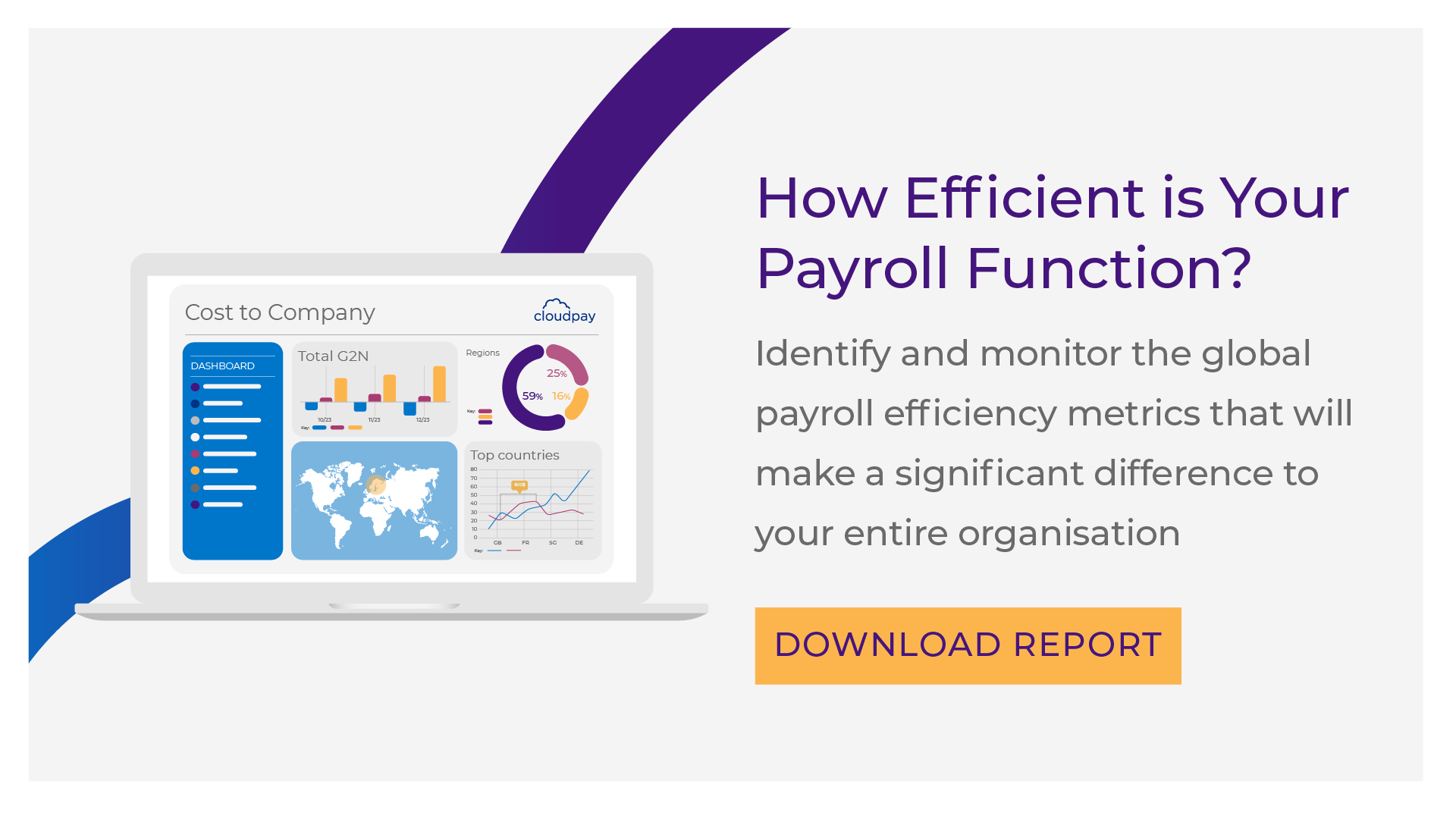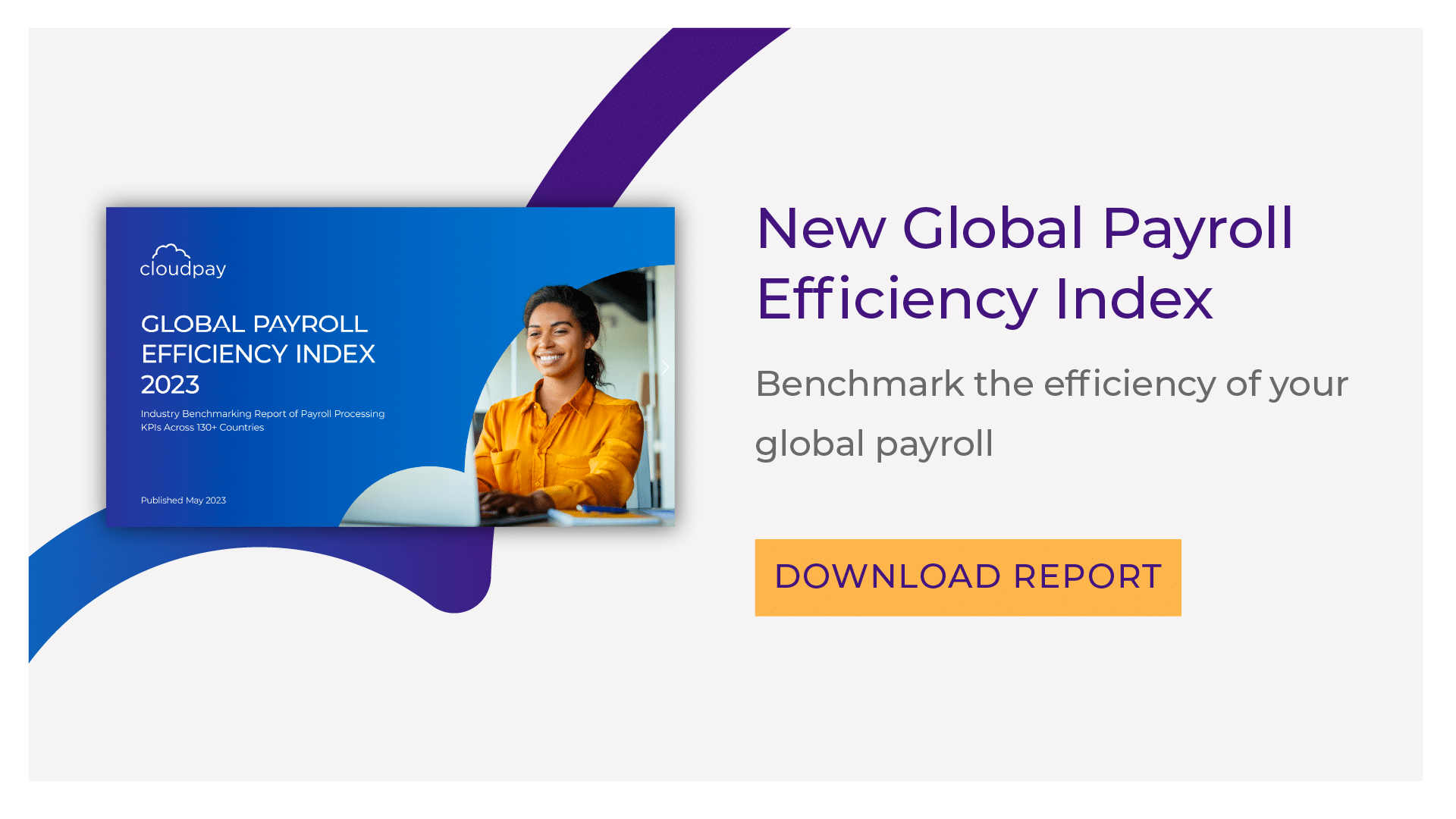Every year, we at Cloudpay put together our Payroll Efficiency Index (PEI) report. And the reason we do so is simple: many businesses aren’t getting sufficient insights into payroll performance from standard SLAs like accuracy and timeliness.
So, we conduct detailed research into payroll performance at national, regional, and global levels, so that you can better understand how and where you can improve payroll performance. We do this using five in-depth KPIs:
- First-time approvals (FTA): the percentage of payroll runs approved first-time, without any changes required
- Data input issues (DII): the proportion of all issues affecting payroll that have been caused by data input mistakes
- Issues per 1000 payslips (I/1000): how many payslips per thousand are affected by issues in each payroll cycle
- Calendar length: how long it takes to complete a payroll cycle end-to-end
- Supplementary impact: the proportion of all payroll runs that take place outside the normal payroll cycle
In this blog, we’ll explore the results of our recently-released 2023 report (based on 2022 data), and how things have changed compared to previous years. We’ll also introduce a new KPI – treasury timeliness – and explore why it’s such an important metric in the modern payroll landscape.
What are the standout differences from last year?
The last two PEI reports have painted a picture of resilience in payroll teams, despite the considerable challenges posed by the pandemic; however, the rate of improvement had slowed in the 2022 report (looking at 2021 data).
This year’s report largely tells a story of continued improvement in 2022: all metrics showed improvements at a global level, except in FTA. This is surprising in a way, as FTA is generally the ‘bellwether’ of all the KPIs, and results within it are normally in step with all the others.
However, the increases posted in the other four KPIs may be down to a larger desire for payroll teams to innovate with technology, something many have been unable to do over the last few years.
What’s changed in the KPIs?
FTA
The drop in the FTA rate compared to the previous year is the first we’ve ever seen in the history of the PEI report. However, it should be noted that it has only dropped by 0.87 percentage points and that there are significant regional variations at play. The figure for the EMEA region dropped by 2%, compared to 0.21% in the Americas, and a 0.08% improvement in Asia-Pacific following a 5.63% gain last year.
DII
The gradual decline of data input issues slowed slightly last year, but accelerated in the 2022 data once again, dropping globally by 3.6 percentage points. This is mainly the result of a record-breaking reduction of 10.2% in the Americas region. We believe the reason for this overall improvement is due to increased integration between payroll and HCM platforms, helping to ensure that payroll data is accurate through direct importing from the HCM system.
I/1000 payslips
The global rate in this metric has now reached a record low of 8.64, after a surprise increase 12 months ago. Much of this is down to a sustained reduction in EMEA: the rate is now just 8.99, having been 15.63 only three years ago. When the disruption within the region over that timespan is considered, it is an especially impressive result that demonstrates how hard businesses there are working to cut these issues out.
Calendar length
Global calendar length shortened by 0.37 days in 2022, the first time it has reduced in three years. Regionally, however, all three areas have changed direction: EMEA shortened by 0.2 days having lengthened in the 2021 data, while Americas and APAC both lengthened after decreasing a year ago. Much like DII, this is an area where greater payroll/HCM integration is having a real positive impact as calendar length can now be shortened without payroll being rushed.
SupplementaI impact
SupplementaI impact rates have fluctuated over the past two years, but the results from the 2022 data represent a level of stagnation: the global increase is just 0.07%, and none of the three regions have posted any significant changes in either direction. This indicates a definite calming down of payroll activity, as payroll teams have been able to complete cycles consistently without any external disruptions.
Treasury
Treasury processes, and the metric of treasury timeliness, is included in the report for the first time. While payroll and treasury generally run separately, inefficiencies in payroll processes have a knock-on effect on treasury and therefore overall performance. The global rate of payments made on time in 2022 is 99.02%, which is a good start but indicates that there is room for improvement by unifying payroll and treasury more closely.
In summary
Our inclusion of treasury timeliness in this year’s PEI report reflects moves by businesses the world over towards modern, integrated pay experiences. As things become even more innovative and integrated in the years to come, we should see further improvements across all six of our KPIs, as companies benefit from fast, flexible global pay services from end to end.
To explore our KPIs and country-specific data in more detail, download the full 2023 PEI report, then discover more on the modern pay experience with Cloudpay.




